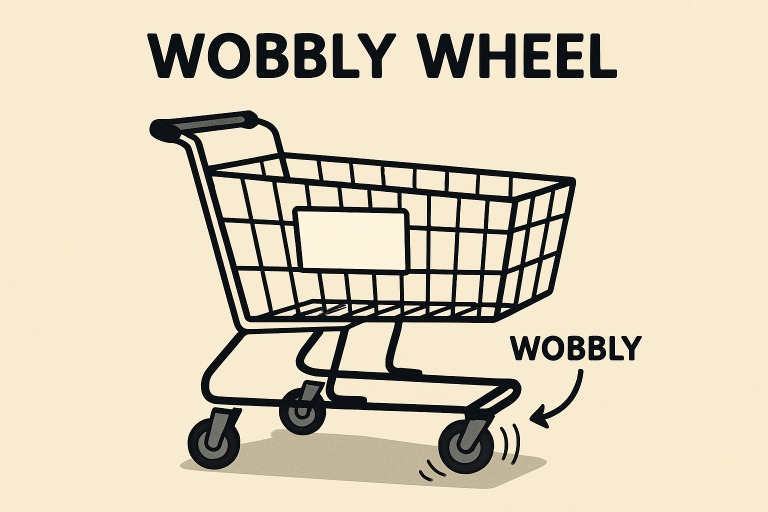Few experiences in a retail store are as universally recognized as the struggle with a wobbly shopping cart. An ordinary trip becomes frustrating when one wheel begins to flutter or veer off course. This phenomenon, technically called caster flutter, happens more often than most shoppers would like. But what exactly causes shopping cart wheels to wobble, and how can stores prevent this nuisance? To answer these questions—whether you’re a curious customer or a retail manager—it’s helpful to understand the mechanics and maintenance requirements for shopping cart wheels and their components.
The quality of your shopping experience often hinges on seemingly small details like wheel smoothness. Unstable wheels don’t just slow you down; they also detract from the impression a store makes. Proactive attention to wheel health ensures a smoother, safer, and more pleasant environment for everyone pushing carts through bustling aisles.
Beyond the evident inconvenience, wobbly wheels pose legitimate safety hazards. They can lead to abrupt stops, sharp turns, and even accidents in crowded areas. Maintaining cart wheels isn’t just about ease of movement—it’s crucial for ensuring customer well-being and operational efficiency in retail settings.
Understanding these causes and solutions helps stores plan effective maintenance strategies and empowers shoppers to select better carts and report issues, ultimately contributing to a higher-quality retail environment.
Common Causes of Wobbly Shopping Cart Wheels
- Loose Swivel Sections: Over time, the swivel mechanism that connects the wheel to the cart frame can loosen through constant use or lack of lubrication. A loose swivel allows the wheel to wobble uncontrollably, manifesting as an annoying flutter at any speed.
- Misalignment: Wheels attached at an improper angle—either from collisions, dropping the cart, or manufacturing defects—will not track straight, causing persistent veering and vibration. This issue is common after a cart has struck a curb or obstacle, bending the caster arm.
- High Speeds: Carts are not designed for speed, especially over uneven floors. Rapid movement increases vibration, and if the wheel assembly can’t keep up, it lifts off the ground periodically, resulting in a loss of steady contact and more wobbling.
- Wear and Tear: Repeated rolling over hard surfaces creates flat spots and unevenness on the wheels. This inconsistency makes it impossible for the cart to roll smoothly, amplifying vibration throughout the frame. Wheels are especially vulnerable in busy, high-traffic stores.
Environmental and Usage Factors
The environments in which shopping carts are used significantly affect the condition of their wheels. Exposure to rain, heat, or cold can damage wheel material and corrode metal fittings. Carts left outside are especially prone to rust, which compromises not only appearance but structural integrity.
- Exposure to Elements: Moisture causes rust on metal components, while UV rays degrade plastic and rubber, making them brittle or misshapen. These cumulative effects become worse each time a cart is left outside.
- Rough Surfaces: Parking lots, curbs, and ramps put extra strain on caster assemblies. Bouncing over rough or uneven surfaces warps metal plates and contributes to wheel misalignment over time.
Maintenance and Prevention Strategies
Routine Inspection and Upkeep
Preventive maintenance is the best way to combat the early signs of wobble. Cart fleets should be routinely inspected for obvious wheel wear, rust buildup, and misaligned components. When a problem is noted, addressing it promptly prevents further issues.
Cleaning and Lubrication
Keeping wheels free from debris like gum, string, or dirt minimizes rolling resistance and wear. Using a suitable lubricant on the swivels and axles ensures smooth motion. It’s also important to use cleaning agents that don’t degrade rubber or plastic wheel coatings.
Timely Replacements
No wheel lasts forever. Retailers should budget to replace wheels and worn caster hardware as part of regular store operations. Modern carts often allow quick wheel swaps, making preventive maintenance efficient and cost-effective.
Design Improvements and Innovations
Materials science and design improvements continually address the age-old problem of wobbly cart wheels. Modern shopping carts feature several technological and engineering upgrades to prolong wheel health and improve cart stability.
- Enhanced Materials: Older carts often use hard plastic or thin rubber wheels, which wear down quickly. Today’s higher-quality carts are increasingly equipped with thick rubber wheels, which dampen vibration, resist flat-spotting, and roll smoothly on multiple surfaces.
- Improved Caster Designs: Advances such as dual-bearing swivels and shock-absorbing caster assemblies can reduce flutter by allowing wheels to absorb irregularities better and remain aligned. These small changes are vital for retailers aiming to retain a safe, accessible fleet of carts.
Impact on Customer Experience
Customer Frustration and Behavior
No shopper enjoys wrestling a cart with a mind of its own. Persistent wobbling slows progress and introduces stress and potential embarrassment in crowded aisles. This negative experience can directly influence whether customers return to a store.
Safety Concerns
Unstable carts create safety risks for everyone in a retail environment. Erratic motion increases the chance of tipping over, colliding with displays, or causing trip hazards for others. These incidents can lead to injury claims, insurance issues, and reputation loss for retailers.
Final Thoughts
Wobbly shopping cart wheels are much more than a simple inconvenience—they affect store safety, reputation, and customer loyalty. By investing in regular maintenance, adopting modern cart technology, and being vigilant about usage conditions, retailers and facility managers can significantly enhance the shopping experience and safety levels. Smoother, more reliable carts are good for business and great for customers.
